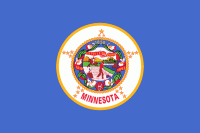|
Trails to the
Past
would appreciate any genealogy information that you may
have such as news items, wills, deaths, births,
biographies etc. if you have any of these items they can
be emailed to Marie Miller the state of
Minnesota Adminstrator
The county seat is
Hastings. Dakota County is named after the Dakota Sioux
tribal bands who settled in the area. The name is
recorded as "Dahkotah" in the United States Census
records until 1851.
In the 1600s,
Mdewakanton Dakota fled their ancestral home of Mille
Lacs Lake in northern Minnesota in response to westward
expansion of the Ojibway nation. According to Dakota
tradition, their ancestors pushed out the Iowa who were
found settled at the mouth of the Minnesota River. Later
in 1680, the Mdewakanton Dakota were contacted by French
explorer Daniel Greysolon, Sieur du Lhut and the Mendota
(mdo-TE) band of the Mdewakanton south of the Minnesota
River were contacted later by Joseph Nicollet in the
18th century. While Taoyateduta (a.k.a. Little Crow) led
the Mendota in northern Dakota County, upstream to the
southwest, Chief Black Dog established his village of
600 people around 1750 at the isthmus between Black Dog
Lake (from which is named after him) and the Minnesota
River, near the present site of the Black Dog Power
Plant.
Following the published expeditions
of explorers, in 1805, Zebulon Pike negotiated for
military territory with the Mendota band which included
land in Dakota County at the Mississippi River
confluences with the Minnesota and St. Croix Rivers. In
1819, on what is now Picnic Island on the south bank of
the Minnesota River, Colonel Henry Leavenworth built a
stockade fort called "St. Peter's Cantonment" or "New
Hope," where materials were assembled for the
construction of Fort Snelling to be built on the bluff
on the north bank. Permanent settlement on the island
was impossible due to annual flooding. Alexis Bailey
built some log buildings nearby to trade in furs in
1826. Henry Hastings Sibley later built the first stone
house in Minnesota in 1836, overlooking Fort Snelling.
Sibley was a partner in the American Fur Company, and
considerable fur trade occurred at Mendota due to the
accessibility of the confluence.
On-going United
States expansion into the then "Northwest Territory" led
to government purchase of land from the Dakota people
(the Mdewakanton, Wahpekute, Wahpeton, and Sisseton
bands) via the Treaty of St. Peters and the Treaty of
Traverse des Sioux in 1851 and the Treaty of Mendota.
After the establishment of the Minnesota Territory in
1849, Dakotah County (later Dakota County) spanned from
the Mississippi River to the Missouri River. By the time
Minnesota achieved statehood in 1858, power and
influence had shifted from Mendota, across the rivers to
Saint Paul
|
On Line
Data |
 |
 |
|
|
|
Cities
Apple
Valley
Burnsville
Coates
Eagan
Farmington
Hampton
Hastings
Inver Grove
Heights
Lakeville
Lilydale
Mendota
Mendota
Heights
Miesville
New
Trier
Northfield
Randolph
Rosemount
South
St. Paul
Sunfish Lake
Vermillion
West St.
Paul
Unincorporated communities
Castle
Rock
Etter
Eureka
Center
Waterford
Ghost
towns
Lewiston
Nininger |
Townships
Castle Rock
Township
Douglas Township
Empire
Township
Eureka Township
Greenvale
Township
Hampton Township
Marshan
Township
Nininger Township
Randolph
Township
Ravenna Township
Sciota
Township
Vermillion
Township
Waterford
Township
|
The information
on Trails to the Past © Copyright may be used in personal family history research, with source citation. The pages in entirety may not be duplicated for publication in any fashion without the permission of the owner. Commercial use of any material on this site is not permitted. Please respect the wishes of those who have contributed their time and efforts to make this free site possible.~Thank you! |



